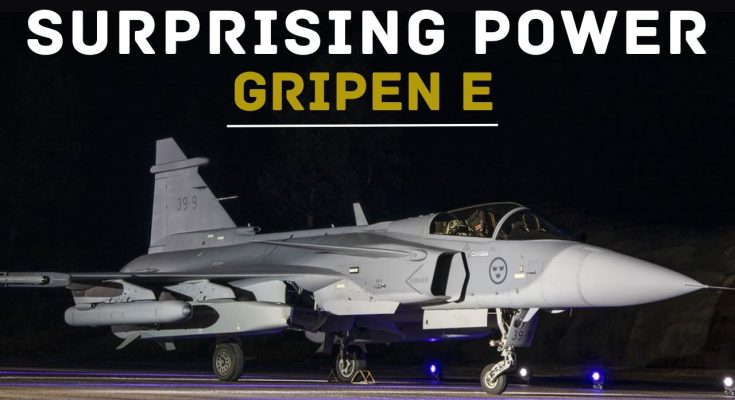The JAS-39 Gripen E, developed by Saab, is one of the most advanced multi-role fighter jets in the world, combining cutting-edge technology with unmatched versatility. Serving as the next-generation model of the Gripen family, the Gripen E brings new features and capabilities that elevate it to the forefront of modern air combat. Here are 6 incredible facts you might not know about the JAS-39 Gripen E.
1. Unmatched Multi-Role Capability
The JAS-39 Gripen E is a true multi-role fighter, capable of performing a wide variety of tasks, including air superiority, ground attack, reconnaissance, and electronic warfare. This flexibility is enhanced by its advanced avionics and powerful radar systems, which allow the aircraft to engage multiple targets simultaneously while operating in complex, high-threat environments. Unlike some fighters that specialize in one type of mission, the Gripen E can quickly adapt to changing conditions on the battlefield, whether it’s engaging enemy aircraft, attacking ground targets, or gathering intelligence.
2. Advanced AESA Radar and Sensor Fusion
One of the most significant upgrades in the Gripen E is its Active Electronically Scanned Array (AESA) radar, the ES-05 Raven, which is far more powerful than that of its predecessor, the Gripen C/D. AESA radar enables the Gripen E to track multiple targets at long ranges with pinpoint precision. Coupled with sensor fusion technology, the Gripen E integrates data from its radar, infrared sensors, and electronic warfare systems, creating a comprehensive battlefield picture for the pilot. This allows for superior situational awareness, even in dense electronic warfare environments, making the Gripen E highly effective in both offensive and defensive operations.
3. Incredible Agility and Short Takeoff Capability
The Gripen E is built to be extremely agile, allowing it to excel in close combat and evasive maneuvers. It is powered by the F414-GE-39E engine from General Electric, which provides a perfect balance of power and efficiency. This engine enables the Gripen E to reach speeds of Mach 2, while still maintaining excellent fuel efficiency. Additionally, the aircraft has a short takeoff and landing (STOL) capability, which makes it incredibly versatile in a variety of operational environments, including austere or improvised airstrips. Its ability to operate from shorter runways gives it a distinct advantage in regions with limited infrastructure or in situations where rapid deployment is essential.
4. Open-Architecture Design for Future Growth
One of the most innovative aspects of the Gripen E is its open-architecture design. Saab built the aircraft with growth potential in mind, meaning that it can easily integrate future technologies as they become available. This design philosophy ensures that the Gripen E will remain operationally relevant for decades to come, as it can be easily updated with new systems, weapons, or avionics. This forward-thinking approach makes the Gripen E a future-proof investment for air forces, ensuring they get the most out of their fleet over time.
5. Cost-Effective Operation and Maintenance
While many modern fighter jets come with hefty price tags, the Gripen E is designed with cost-effectiveness in mind. Saab has focused on creating a jet that offers high-end performance without the exorbitant operational costs seen in other fighters like the F-35. The Gripen E’s design allows for easy maintenance and quick turnaround times, reducing the overall cost of ownership. This makes it an attractive option for countries with limited defense budgets, offering a balance between affordability and high-performance capabilities. Additionally, the aircraft’s long service intervals and modular systems allow for efficient maintenance procedures, keeping the fleet operational with minimal downtime.
6. Global Multi-National Adoption
The Gripen E has attracted interest from a range of countries around the world, not just Sweden, where it was developed. The aircraft has been selected by Brazil as the backbone of its air force and has also been ordered by Switzerland and Hungary, among other nations. This global interest in the Gripen E highlights its interoperability with allied forces and its appeal to countries seeking a highly capable, versatile, and cost-effective fighter. The Gripen E’s ability to operate seamlessly with NATO forces and its strong reputation for reliability and performance are key reasons for its increasing adoption across the globe.
Conclusion
The JAS-39 Gripen E is a fighter that punches well above its weight class, offering advanced technology, exceptional versatility, and cost-effective operations. From its ability to adapt to a wide range of combat missions to its future-proof design and global appeal, the Gripen E is a perfect example of how cutting-edge technology can be harnessed to create a world-class, multi-role fighter that meets the needs of modern air forces. Its remarkable features ensure that the Gripen E will remain a key player in the global fighter jet market for years to come.



